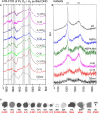Plasma & Microwaves as Greener Options for Nanodiamond Purification: Insight Into Cytocompatibility
- PMID: 34277579
- PMCID: PMC8278578
- DOI: 10.3389/fbioe.2021.637587
Plasma & Microwaves as Greener Options for Nanodiamond Purification: Insight Into Cytocompatibility
Abstract
The potential biomedical applications of nanodiamond have been considered over the last few decades. However, there is still uncertainty regarding the extent to which the surface characteristics of this material can influence potential applications. The present study investigated the effects of surface characteristics alongside the prospective of improving nanodiamond production using cold plasma and microwave technologies for the surface tailoring of the nanocarbons. Numerous approaches were applied to purify, refine and modify a group of nanosized diamonds at each step of their production cycle: from the detonation soot as the initial raw material to already certified samples. The degree of surface changes were deliberately performed slowly and kept at different non-diamond carbon presence stages, non-carbon elemental content, and amount converted superficial moieties. In total, 21 treatment procedures and 35 types of nanosize diamond products were investigated. In addition cultures of human fibroblast cells showed enhanced viability in the presence of many of the processed nanodiamonds, indicating the potential for dermal applications of these remarkable nanomaterials.
Keywords: cytotoxicity; microwave; modification; nanocarbon; nanodiamond; nanomaterial; plasma treatment; purification.
Copyright © 2021 Mitev, Alsharabasy, Morrison, Wittig, Diener and Pandit.
Conflict of interest statement
SW and CD were employed by company Diener Electronic GmbH + Co. KG. The remaining authors declare that the research was conducted in the absence of any commercial or financial relationships that could be construed as a potential conflict of interest.
Figures













Similar articles
-
Surface Control of Nanodiamond: From Homogeneous Termination to Complex Functional Architectures for Biomedical Applications.Acc Chem Res. 2022 Dec 20;55(24):3594-3604. doi: 10.1021/acs.accounts.2c00596. Epub 2022 Nov 29. Acc Chem Res. 2022. PMID: 36445945
-
Detonation nanodiamonds biofunctionalization and immobilization to titanium alloy surfaces as first steps towards medical application.Beilstein J Org Chem. 2014 Nov 26;10:2765-2773. doi: 10.3762/bjoc.10.293. eCollection 2014. Beilstein J Org Chem. 2014. PMID: 25550742 Free PMC article.
-
Surface Modification of Fluorescent Nanodiamonds for Biological Applications.Nanomaterials (Basel). 2021 Jan 9;11(1):153. doi: 10.3390/nano11010153. Nanomaterials (Basel). 2021. PMID: 33435443 Free PMC article. Review.
-
Biomedical applications of nanodiamond (Review).Nanotechnology. 2017 Jun 23;28(25):252001. doi: 10.1088/1361-6528/aa6ae4. Epub 2017 Apr 3. Nanotechnology. 2017. PMID: 28368852
-
Predicting the impact of structural diversity on the performance of nanodiamond drug carriers.Nanoscale. 2018 May 17;10(19):8893-8910. doi: 10.1039/c8nr01688g. Nanoscale. 2018. PMID: 29737997 Review.
Cited by
-
Silver and Carbon Nanomaterials/Nanocomplexes as Safe and Effective ACE2-S Binding Blockers on Human Skin Cell Lines.Molecules. 2024 Jul 29;29(15):3581. doi: 10.3390/molecules29153581. Molecules. 2024. PMID: 39124987 Free PMC article.
References
-
- Aizawa T. (2019). “Controlled post-treatment of thick CVD-diamond coatings by high-density plasma oxidation,” in Chemical Vapor Deposition for Nanotechnology, ed. Mandracci P. (London: IntechOpen; ), 75–94.
-
- Anton Paar (2019). The Zeta Potential of Track-Etched PVDF Membranes. Available online at: https://www.anton-paar.com/corp-en/products/applications/the-zeta-potent... (assessed September 17, 2019)
-
- Arnault J. C. (2016). “Nanodiamonds: from synthesis and purification to deposition techniques, hybrids fabrication and applications,” in Carbon Nanoparticles and Nanostructures, eds Yang N., Jiang X., Pang D. W. (Cham: Springer; ), 1–45.
-
- Atkinson R. J., Posner A. M., Quirk J. P. (1967). Adsorption of potential-determining ions at the ferric oxide-aqueous electrolyte interface. J. Phys. Chem. 71 550–558. 10.1021/j100862a014 - DOI
LinkOut - more resources
Full Text Sources

